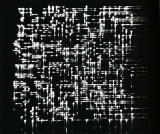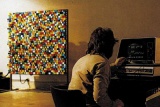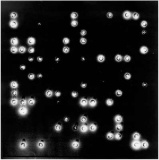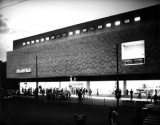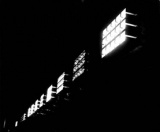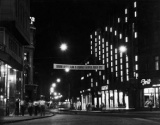Difference between revisions of "Vladimir Bonačić"
| Line 8: | Line 8: | ||
|death_place = Ittenbach, [[Germany]] | |death_place = Ittenbach, [[Germany]] | ||
}} | }} | ||
| − | Croatian computer artist and cybernetician. Born 1938 in Novi Sad, Yugoslavia. Grew up in Zagreb and studied electronics at the Faculty of Electrical Engineering and Computing, University of Zagreb ( | + | Croatian computer artist and cybernetician. Born 1938 in Novi Sad, Yugoslavia. Grew up in Zagreb and studied nuclear electronics at the Faculty of Electrical Engineering and Computing, University of Zagreb (M. Sc. 1964) Postgraduate studies in London and Paris. Earned his PhD in 1967 in the field of pattern recognition and hidden data structures, at the university of Zagreb. |
| − | In 1968 he started to utilize computer systems for cybernetic art. 1969–1973 | + | In 1968 he started to utilize computer systems for cybernetic art. 1969–1973 director of the Laboratory for Cybernetics at the Ruđer Bošković Institute in Zagreb, where he worked already since 1964; in 1970-1972 he led the research project "Pattern Recognition and Processing". At that time the also began development of "Computer Controlled Dynamic Object" with the support of UNESCO; and in 1971 served as an advisor to the UNESCO on art and science matters. Exhibited his first dynamic objects within [[New Tendencies]] exhibition in [[Zagreb]] in [[1969]], altogether 17 works, and then again in [[1973]]. He worked together with [[Ivan Picelj]], and since late 1960s with a software designer [[Miro A. Cimerman]]. His first solo exhibition took place in [[Ljubljana]] in 1972. |
| − | On the basis of an agreement between the Ruđer Bošković Institute and the Israel Academy of Sciences Bonačić established a laboratory team for cybernetics, [[bcd]], together with Cimerman and an architect [[Dunja Donassy]] (1971). In 1972 '''bcd - cybernetic art team''' moved to Israel and in 1973 founded the "Jerusalem Program in Art and Science", a research and training program for post-graduate interdisciplinary studies in art and science at the Bezalel Academy of Arts and Design in Jerusalem, which Bonačić directed until 1977, serving as a professor of computer-based art. For this program he established collaborations with the Hebrew University of Jerusalem and the Israel Museum. | + | On the basis of an agreement between the Ruđer Bošković Institute and the Israel Academy of Sciences Bonačić established a laboratory team for cybernetics, [[bcd]], together with Cimerman and an architect and city planner [[Dunja Donassy]] (1971). In 1972 '''bcd - cybernetic art team''' moved to Israel and in 1973 founded the "Jerusalem Program in Art and Science", a research and training program for post-graduate interdisciplinary studies in art and science at the Bezalel Academy of Arts and Design in Jerusalem, which Bonačić directed until 1977, serving as a professor of computer-based art. For this program he established collaborations with the Hebrew University of Jerusalem and the Israel Museum. On 3-14 November 1974 he organized an international Bat Sheva seminar on [[The Interaction of Art and Science]], in which several New Tendencies protagonists, such as [[Jonathan Benthall]], [[Herbert W. Franke]], [[Frank Joseph Malina]], [[Abraham A. Moles]], [[A. Michael Noll]], and [[John Whitney]], participated. In 1975, [[Willem Sandberg]], a Dutch typographer and director of the [[Stedelijk Museum]], received the Erasmus Prize in Amsterdam. On Sandberg's recommendation, half of the prize was dedicated to "The Jerusalem Program in Art and Science".<ref>Fritz, Darko (2010). [http://www.bcs.org/upload/pdf/ewic_ca10_s1paper4.pdf "The Computer-Generated Artworks of Vladimir Bonačić"]. London: CAT 2010 London Conference: p 43.</ref> |
In 1973 he became a member of the editorial advisory board of the journal [[Leonardo]]. 1978/1979 head of development of the multimedia and electronic library at the national library of Croatia, Zagreb, and the central library of the University of Zagreb. Moved to Germany in 1980 where he undertook R&D projects primarily in visual communications used by German television for election night reporting. He died 1999 in Germany. | In 1973 he became a member of the editorial advisory board of the journal [[Leonardo]]. 1978/1979 head of development of the multimedia and electronic library at the national library of Croatia, Zagreb, and the central library of the University of Zagreb. Moved to Germany in 1980 where he undertook R&D projects primarily in visual communications used by German television for election night reporting. He died 1999 in Germany. | ||
| Line 22: | Line 22: | ||
<gallery> | <gallery> | ||
| + | File:Picelj, Ivan; Bonačić, Vladimir (1968) - T-4.jpg|''T4''. Computer-controlled dynamic object, aluminum, light bulbs, electric parts, 70 × 50 × 6 cm, 1968. With Ivan Picelj. | ||
| + | File:Bonacic, Vladimir (1969) - DIN. GF100.jpg|''DIN. GF100''. Metal construction, electronics, electric lamps, colored transparency film, plexiglas, 135 × 152.5 × 25 cm, 1969 | ||
| + | File:Bonacic, Vladimir (1969) - PLN 6.jpg|''PLN 6''. Computer-generated image. PDP-8, oscilloscope, 1969. | ||
| + | File:Bonacic, Vladimir (1969) - IR. PLNS. 0044. 7714. 7554. 7744.jpg|''IR. PLNS. 0044. 7714. 7554. 7744''. Computer-generated image. PDP-8, oscilloscope, 1969 | ||
| + | File:Bonacic, Vladimir (1969-70) - GF.E 32-S.jpg|''GF.E 32-S''. Computer-controlled dynamic object, aluminum, light bulbs, electric parts, 68 × 68 × 12 cm, 1969-70 | ||
File:Bonacic-GF.E-6.4.jpg|''Dynamic Object GF.E (16,4)''. Computer-controlled dynamic object, aluminum, light bulbs, electric parts, 68 × 68 × 12 cm, 1969-70 | File:Bonacic-GF.E-6.4.jpg|''Dynamic Object GF.E (16,4)''. Computer-controlled dynamic object, aluminum, light bulbs, electric parts, 68 × 68 × 12 cm, 1969-70 | ||
File:Bonacic GF.E-16-4-CNSM.jpg|''Dynamic Object GF.E (16,4)'', 1969-70 | File:Bonacic GF.E-16-4-CNSM.jpg|''Dynamic Object GF.E (16,4)'', 1969-70 | ||
File:Bonacic GFE16 4 1971.jpg|''Dynamic Object GF.E (16,4)'', 1969-70 | File:Bonacic GFE16 4 1971.jpg|''Dynamic Object GF.E (16,4)'', 1969-70 | ||
| − | |||
</gallery> | </gallery> | ||
; 'True randomly generated' kinetic object | ; 'True randomly generated' kinetic object | ||
| − | ''Random 63''. 63 true random generators, light bulbs, aluminum, 76 × 76 × 7 cm, 1969. | + | <gallery> |
| + | File:Bonacic, Vladimir (1969) - Random 63.jpg|''Random 63''. 63 true random generators, light bulbs, aluminum, 76 × 76 × 7 cm, 1969. | ||
| + | </gallery> | ||
Revision as of 19:31, 14 March 2012
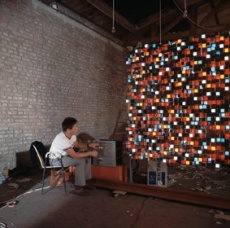 GF.E 16/4 (1969 - 1970) | |
| Born |
October 20, 1938 Novi Sad, Yugoslavia |
|---|---|
| Died |
August 15, 1999 (aged 60) Ittenbach, Germany |
Croatian computer artist and cybernetician. Born 1938 in Novi Sad, Yugoslavia. Grew up in Zagreb and studied nuclear electronics at the Faculty of Electrical Engineering and Computing, University of Zagreb (M. Sc. 1964) Postgraduate studies in London and Paris. Earned his PhD in 1967 in the field of pattern recognition and hidden data structures, at the university of Zagreb.
In 1968 he started to utilize computer systems for cybernetic art. 1969–1973 director of the Laboratory for Cybernetics at the Ruđer Bošković Institute in Zagreb, where he worked already since 1964; in 1970-1972 he led the research project "Pattern Recognition and Processing". At that time the also began development of "Computer Controlled Dynamic Object" with the support of UNESCO; and in 1971 served as an advisor to the UNESCO on art and science matters. Exhibited his first dynamic objects within New Tendencies exhibition in Zagreb in 1969, altogether 17 works, and then again in 1973. He worked together with Ivan Picelj, and since late 1960s with a software designer Miro A. Cimerman. His first solo exhibition took place in Ljubljana in 1972.
On the basis of an agreement between the Ruđer Bošković Institute and the Israel Academy of Sciences Bonačić established a laboratory team for cybernetics, bcd, together with Cimerman and an architect and city planner Dunja Donassy (1971). In 1972 bcd - cybernetic art team moved to Israel and in 1973 founded the "Jerusalem Program in Art and Science", a research and training program for post-graduate interdisciplinary studies in art and science at the Bezalel Academy of Arts and Design in Jerusalem, which Bonačić directed until 1977, serving as a professor of computer-based art. For this program he established collaborations with the Hebrew University of Jerusalem and the Israel Museum. On 3-14 November 1974 he organized an international Bat Sheva seminar on The Interaction of Art and Science, in which several New Tendencies protagonists, such as Jonathan Benthall, Herbert W. Franke, Frank Joseph Malina, Abraham A. Moles, A. Michael Noll, and John Whitney, participated. In 1975, Willem Sandberg, a Dutch typographer and director of the Stedelijk Museum, received the Erasmus Prize in Amsterdam. On Sandberg's recommendation, half of the prize was dedicated to "The Jerusalem Program in Art and Science".[1]
In 1973 he became a member of the editorial advisory board of the journal Leonardo. 1978/1979 head of development of the multimedia and electronic library at the national library of Croatia, Zagreb, and the central library of the University of Zagreb. Moved to Germany in 1980 where he undertook R&D projects primarily in visual communications used by German television for election night reporting. He died 1999 in Germany.
Works
- Application of Galois fields to kinetic computer-art objects
Dynamic Object GF.E 32-S. Computer-controlled dynamic object, aluminum, light bulbs, electric parts, 68 × 68 × 12 cm, 1969–1970
DIN.GF 100. Pseudo-random audiochromatic computer-controlled dynamic object, 147 × 123 × 12 cm, 1969
- 'True randomly generated' kinetic object
- Public space computer-controlled light installations
Notes
- ↑ Fritz, Darko (2010). "The Computer-Generated Artworks of Vladimir Bonačić". London: CAT 2010 London Conference: p 43.
Bibliography
- Darko Fritz, "Vladimir Bonačić - Early Works, Zagreb 1968-1971", in: CIP, no. 07-08, 2006, UHA, Zagreb, pp. 50 -55 [1] [2]
- Darko Fritz, "Vladimir Bonačić: Computer-Generated Works Made Within Zagreb’s New Tendencies Network (1961–1973)", in: Leonardo, Volume 41, Number 2, April 2008, pp. 175-183 [3]
- Boris Čučković, "Vladimir Bonačić: objekti, urbane instalacije i primijenjeni pseudoslučaj. Zagreb 1968 – Jeruzalem 1978", Rector award winning papers published on official pages of the University of Zagreb. Zagreb: University of Zagreb, Faculty of Humanities and Social Sciences, 2010. [4]
- Darko Fritz, "The Computer-Generated Artworks of Vladimir Bonačić", CAT 2010 London Conference, 2010. [5]


